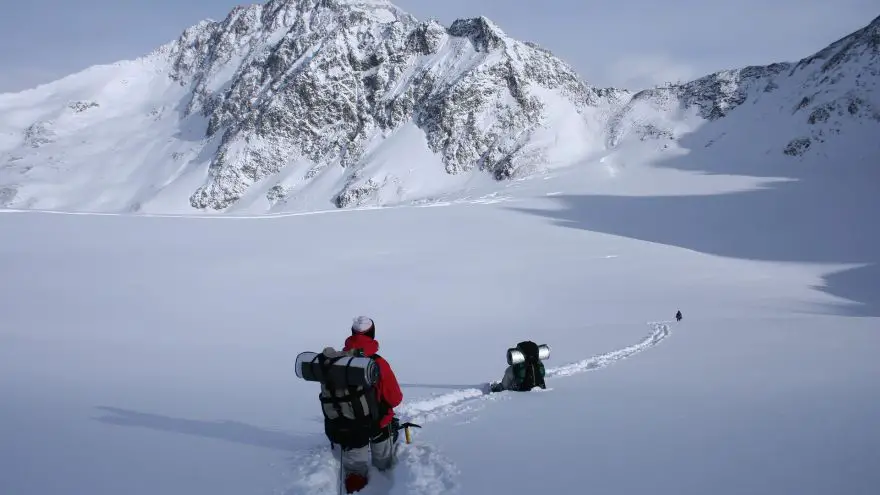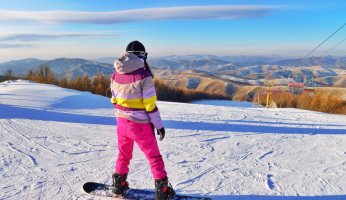Winter Hiking Hazards
 Winter Hiking Hazards
gearweare.net
Winter Hiking Hazards
gearweare.net
Hiking in the winter offers a sense of solitude and adventure that draws many people despite the frigid temperatures. Mountain landscapes are transformed by snow. A hush falls over the woods as plants are buried and animals revert to more sedentary states. Above tree line, winter winds and icy slopes create an environment that is decisively unwelcoming. For many this harshness is part of the appeal. To survive here proper knowledge and gear are necessary, and a small mistake can have deadly consequences.
Embarking on a wintertime hike is not something that should be taken lightly, especially if the goal is to summit peaks above tree line. The snow, ice, cold, and short days all work together to make this pastime far more dangerous than it is during the other three seasons. Understanding what could potentially go wrong is crucial to mitigating these problems. An awareness of what to do in an emergency is also crucial. The mountains are unpredictable, especially in the winter, and even the most prepared hikers sometimes face disaster.
Hypothermia and Frost Bite
Freezing temperatures are more than just uncomfortable; If you are not properly prepared to encounter them they can also be quite dangerous.
Hypothermia, which occurs when the temperature of one’s inner core drops, is a common ailment of those who venture outside during the winter months. It causes the deterioration of both mental and physical capacities. Once it has set in, hypothermia has been known to cause individuals to lie down in the down in the snow, strip off their clothes, and become hostile and irrational towards their companions. This illogical behavior is often deadlier than the inner cooling that caused it.
The signs of hypothermia are progressive so it is important to keep an eye out for early warnings. Look for extreme shivering, clumsiness, and reduced mental awareness in your hiking partners. If they begin to show these symptoms check in with them to make sure that they are warm enough. Find some shelter where it’s easy to get warm again. If that isn’t an option or if the issue doesn’t resolve itself, turning around is the safest course of action.
Frostbite is another potential hazard of venturing outside in the extreme cold. It occurs when skin freezes due to decreased blood flow caused by frigid temperatures, and is most common in fingers, toes, and on exposed skin. It is treatable; however, timeliness is everything. Cover the affected area if it is unprotected and get the victim somewhere warm as quickly as possible. Do not rub the skin, as this can cause ice crystals imbedded in it to cut the skin. Hot water can also be more damaging than helpful since the numbness caused by frostbite can leave the victim unaware if they are being burned. Place the frostbitten skin in warm water or under a damp washcloth. If the skin does not return to normal or is black, head to the ER.
Proper layering is the most surefire way to avoid problems caused by the cold. Wear a moisture wicking layer against your skin, an insulating layer above that, and a water and windproof shell above everything else. Wrist and boot gators are also a crucial aid to keeping snow and moisture out of critical areas. Pick clothing that lies loosely, as this allows hot air from body heat to move more freely. Tight clothing cuts off circulation and traps cold. Finally, make sure to delayer if you begin to get hot. The moisture from sweat can wet your clothing, which drastically increases the chances of hypothermia and frostbite.
Problems Caused by Snow and Ice
The snow may be beautiful, but it is also treacherous. Avalanche danger is something that needs to be considered carefully before embarking on a wintertime hike. Avoid hiking just after heavy snowfall, especially if the weather is sunny or warm. A mild winter day may seem like the most appealing time to go hiking but the higher temperatures tend to loosen snow, making avalanches more likely. If you plan to venture into an avalanche prone area, safety devices such as beacons, probes, shovels and airbags can save you or your partners life. Pay attention to what trails the forest service has opened or closed while planning your adventure, and never enter a closed area. There is always a reason for the closure.
Deep snow creates other issues as well. If you don’t have the proper footwear, you may find yourself knee or crotch deep with each step known as “post holing”, and even with snowshoes or skis breaking in a fresh trail can be quite hard. Be prepared to move more slowly. By covering cairns and trail signs, snow also makes it easier to get lost. Make sure to bring a map and compass with you even if you will only be hiking for a few hours. Finally, it is possible for snow covered bushes and the area around trees to create hollow areas under the snow known as “tree wells”. Stepping on these areas can cause you to sink deeply into the snow, and once you are trapped it can be incredibly difficult to crawl your way out. Staying on snowy paths that have already been trampled down by other hikers is a good way to avoid all three of these issues.
Ice is another hazard that needs to be accounted for while winter hiking, especially in steep areas. Some conditions leave no room for error, and a fall on slippery terrain can be impossible to arrest. Know what conditions you will be encountering before setting out, and prepare accordingly. Make sure you have the proper foot gear. Snowshoes work well in snow, but on icy terrain traction aids like yaktrax, microspikes, or crampons will be much more effective. Always have polls with you as well as they create two more points of contact, making it easier to stay balanced.
Other Considerations
It is important to remember that winter days are much shorter. When planning a hike during this season be prepared to be off the mountain before the sun sets. If you are setting up camp, be sure to have everything ready before dark. All the hazards detailed above are exasperated by the dark and increased cold of night.
Finally, unless you are very experienced, never hike alone in the winter. Having a partner helps mitigate any problem that may arise and can make all the difference if disaster does strike. It is also prudent to let someone who isn’t coming on the hike know about your plans. Tell them what time you intend to be back and who they should alert if you don’t check in with them by then.











